Join us on a day in the life journey, as Trip Leader Lori Anderson shares her Notes from the Field on our Tanzania Women’s Adventure Safari Best of Northern Circuit Trip Report.
• Day 1 •
Arusha National Park
Today begins our adventure in Tanzania!

We left our beautiful accommodations at Lake Duluti lodge for a full day at Arusha National Park.
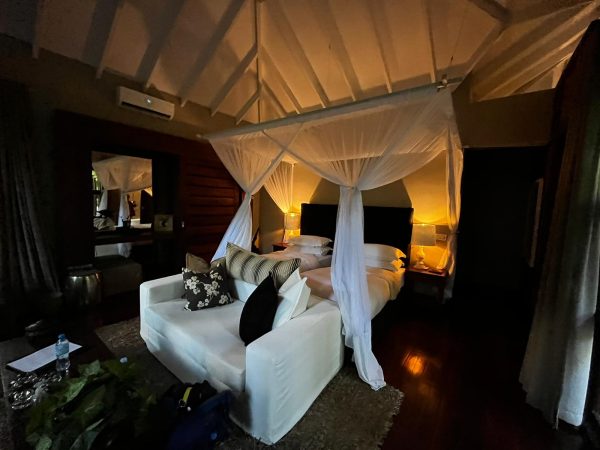
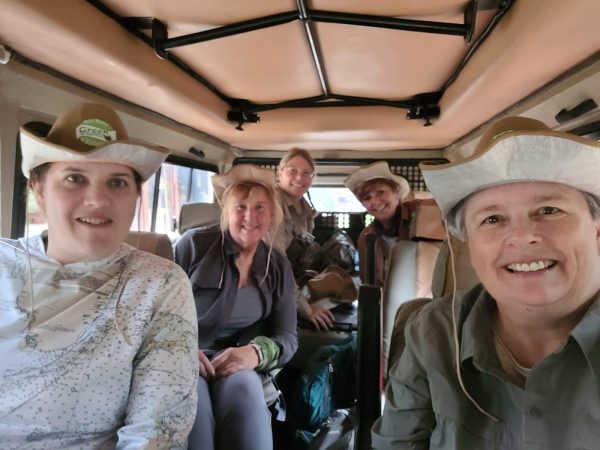
Tanzania has 22 National Parks in total and Arusha NP is a little-known gem. The landscape is varied from lush rainforest to a small ‘Serengeti’.
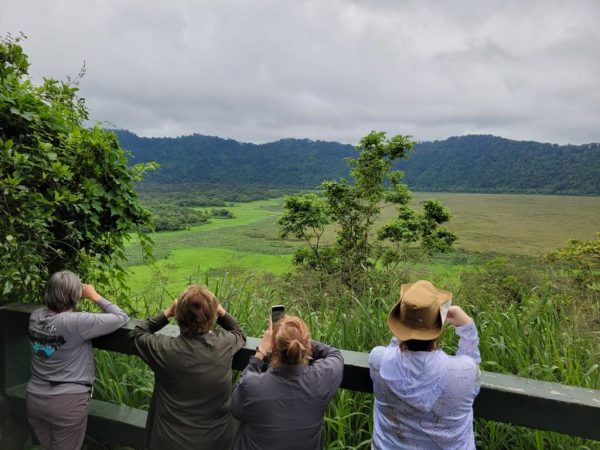
This day gives us our first wild animal sightings! None of the TZ parks are fenced in.
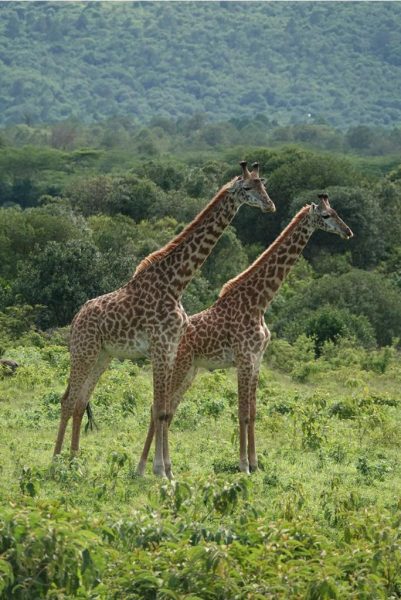
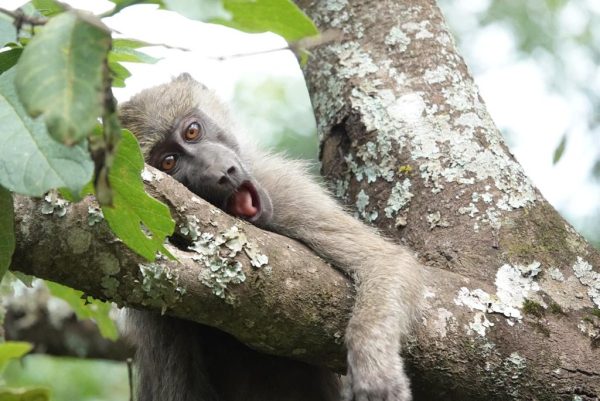
We saw zebras, warthogs, Cape buffalo, giraffes, baboons, Colobus monkeys, red duiker, and much more!”
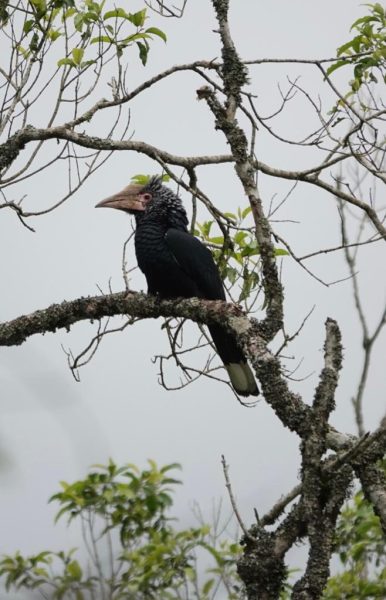
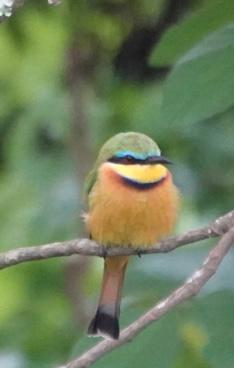
• Day 2 •
Ngorongoro Crater
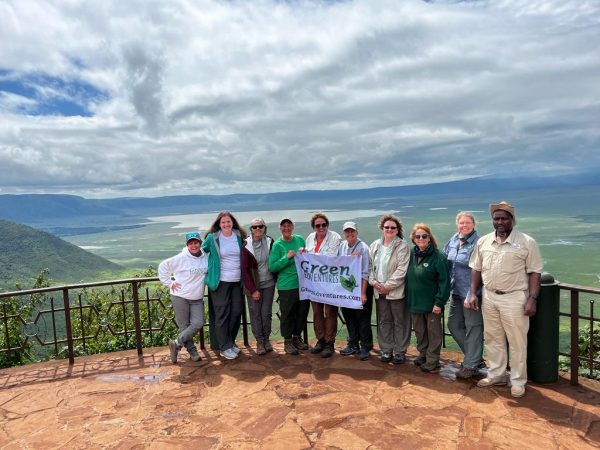
We are surrounded by a heavy fog as we drive along the rim of the Ngorongoro crater. The wet red dirt road is in stark contrast to the lush green rainforest. We wind our way down into the crater. It’s impossible to see if the crater is on our left or right.
The Ngorongoro Crater was formed 2-3 million years ago by the collapse of a volcanic mountain. The crater floor measures approximately 100 sq miles.
When we reach the crater floor, the fog is gone, and we can see rays of sunshine breaking through. Looking closer, it’s clear we weren’t just driving in fog but passing through a cloud bank that remains around the rim all day long. The feeling is surreal.
Below the rim is a giant ‘fishbowl’ of life!
The crater floor has its own ecosystem including a lake and river. The crater is large enough to support the African Big 5. (Lion, rhino, elephant, Cape buffalo, and leopard.).
Thousands of gazelles, zebra, wildebeest, eland, flamingos, elephants, and lions can be found here and much much more! They are often crossing the road in front of us.
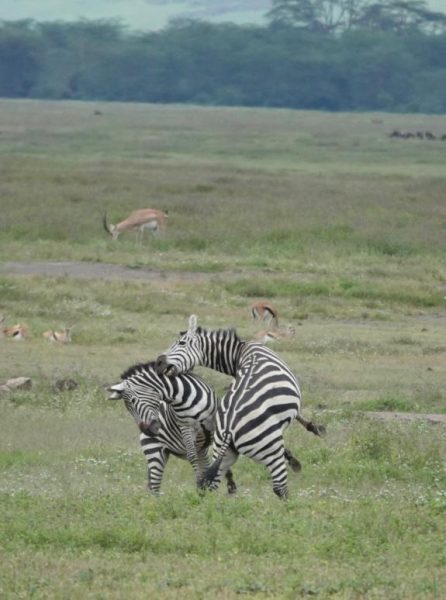
It doesn’t take long for everyone to sharpen their eye for spotting game. Shouts of ‘Zebras on the right!’, ‘Elephants on the left!’ are heard throughout the day.
A group of four lions are lying sprawled out yet stacked tightly next to each other. From a distance they look like bags of sand.
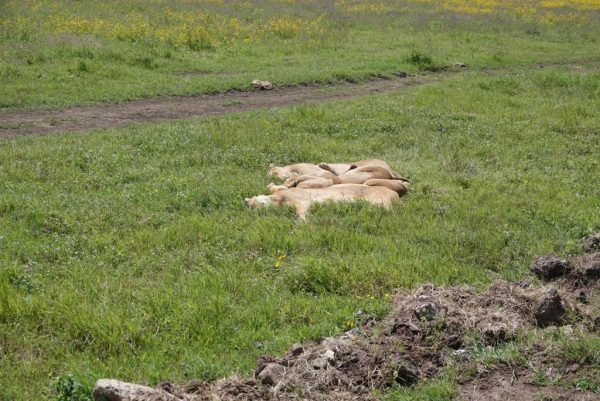
It’s not until we are very close that we realize what we’re looking at. We’re a mere 20 feet away. A young male makes his way through the tall grass and joins them, plopping himself down in the middle.
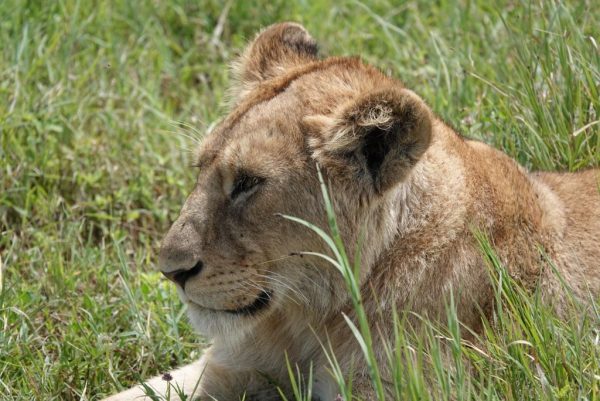
By days end our species list has grown immensely. We’ve seen four out of the Big 5 – Lion, elephant, Cape Buffalo, and rhino.
• Day 3 •
Visit Masai Tribe and Olduvai Gorge
The tribe we visited today on our Tanzania Women’s Adventure Safari Best of Northern Circuit lives just outside the Ngorongoro Crater in a small village of huts; one for each individual family.
We wrap ourselves in blankets and a Masai member adjusts the knot. They place intricately beaded neckwear on each of us and invite us to watch and then join in on the dancing.
We were greeted by their welcoming dance, a competition of how high the men can jump, and a fire-building demonstration.
The women work together to build the huts. All huts are the same size and are made of cow dung.
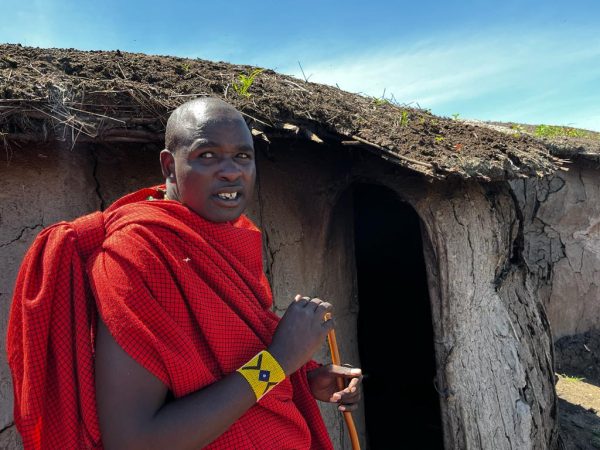
Entrance to hut
It takes about two weeks to build and is replaced every nine months. She learns this skill from her mother. Each wife has her own hut. It has one open area that contains one bed for all the children, and one bed for her. The men have no limit to the number of wives they can have. That said, cattle are used to pay a dowry so wealth and the number of wives a man can have is determined by the number of cattle he owns. The man decides which wife he’ll spend the night with.
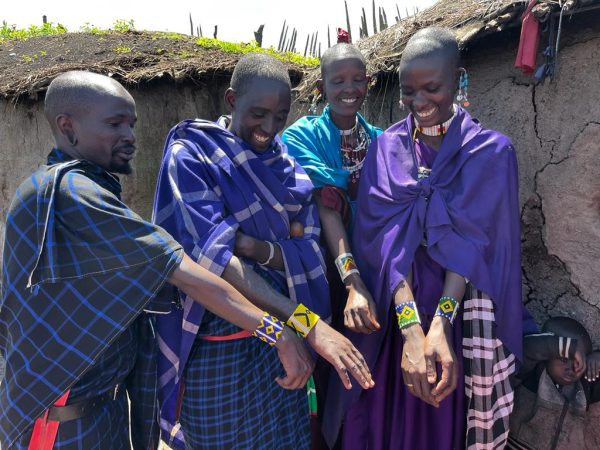
The beds have no mattress. When possible, they sleep on a cow hide. Each hut also contains a room for a calf to spend the night. This keeps the calf safe from predators – lions and leopards. In the center of the hut is a small pit for fire; used primarily for cooking. It’s very dark inside – a small opening on the roof provides the only light.
Their diet is milk or milk mixed with fresh blood from cows. They use an arrowhead to drain blood from the cow’s jugular vein, then patch the puncture wound with cow dung. They also eat goat and sheep meat. Beef is only eaten at special ceremonies. They have no fruit or vegetables.
In the center of the village is a marketplace set up to display a wide variety of crafts made by the women.
The kindergarten classroom is for children ages 2-5. They learn both Swahili and English and are very proud to demonstrate what they’ve learned. After kindergarten, they attend a primary school that is a 7km (4.5mile) walk away.
Olduvai Gorge
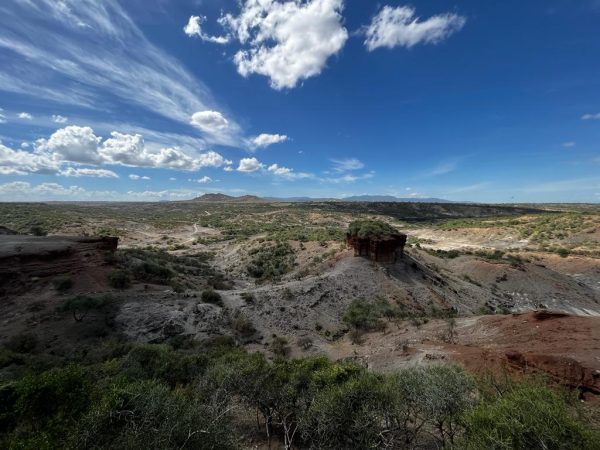
We stopped for lunch and a short lecture at the Olduvai Gorge; a 34-mile stretch known as the cradle of mankind. The area is rich in the history of early man. It’s known that a shallow lake was once present, supporting people and a variety of animals. Teams from universities around the world continue to excavate the area. Animal and human remains are found on a regular basis.
We ended our day arriving at our tent camp in the Serengeti. We’ll spend the next few days on the lookout for wild animals and beautiful birds. The drive into our camp gave us a taste for what’s in store.
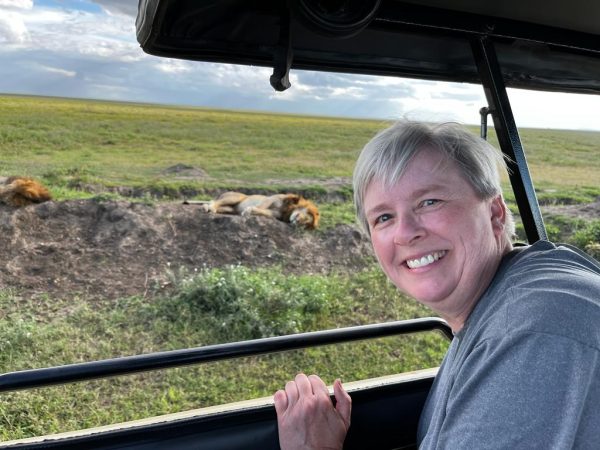
We saw many sleeping lions alongside the road and one in a tree, in addition to Zebras, Gazelles, Spotted hyena and baby hyenas, Ostrich and Impala.
If this trip is on your bucket list, we would love to have you join us next year on our Tanzania Women’s Adventure Safari Best of Northern Circuit
• Day 4 •
Hippos! Hippos! Hippos!
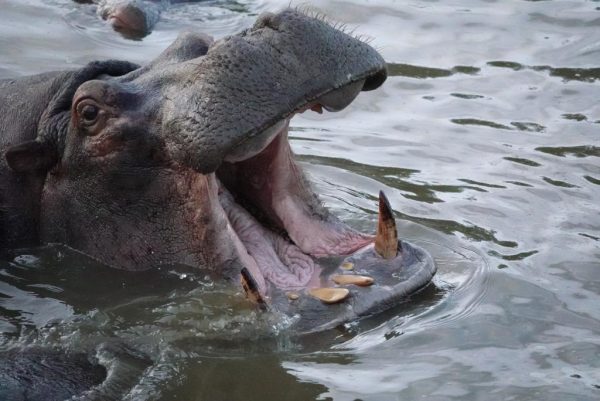
We got up before sunrise today and arrived at the hippo pool just as daylight is breaking! We can hear them before we see them. Their grunts and snorts are loud.
Hippos spend the evening out in the grasslands, grazing on the grass all night long. In the morning, they slowly make their way back to the hippo pool.
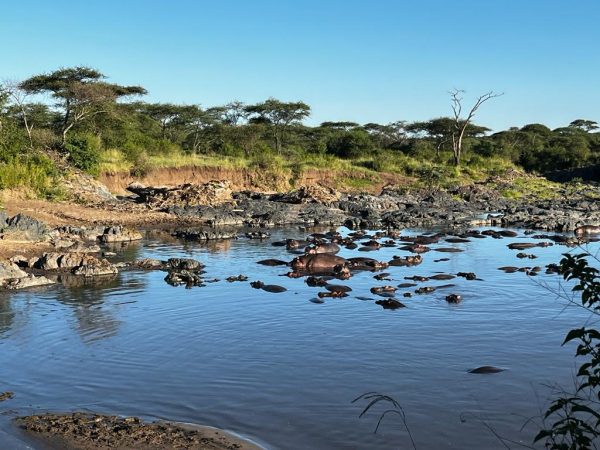
The river where we catch up with them is holding well over a hundred!
• Day 5 •
Sunrise on the Serengeti
Sunrise on the Serengeti. Beautiful. Serene. Mesmerizing.
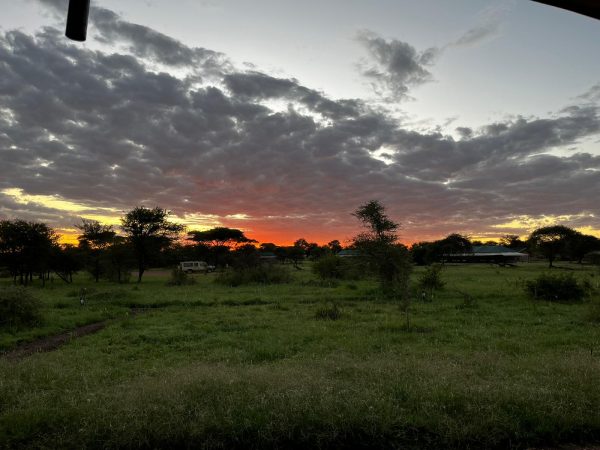
We’re greeted by a giraffe walking through our camp. He’s eating his way around the tall acacia trees Giraffes are the Tanzanian National Animal.
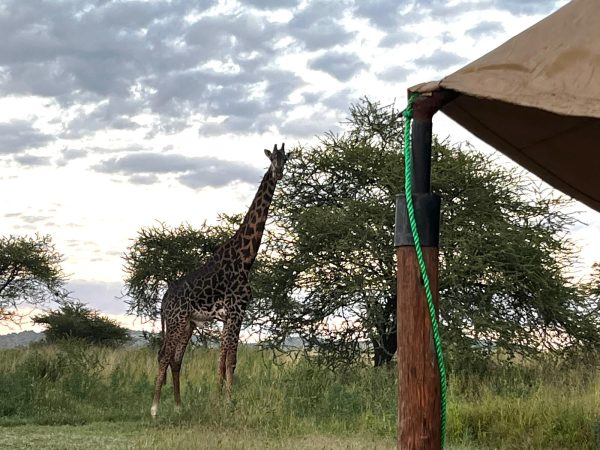
They are a peaceful animal. Humble. Calm. Gentle. Quiet. These endearing attributes also describe the people of Tanzania. Many, many different tribes are found in Tanzania and they all get along.
Traveling to Africa teaches us on many levels.
Hakuna matata!
• Day 6 •
The Serengeti
The name ‘Serengeti’ is derived from a Maasai word and means ‘endless plains’. This is an accurate description. The area spans 12,000 square miles. The majority of it lies in Tanzania with a small northern section in Kenya.
We are here for three days and three nights. We are staying at a beautiful tent campsite.
Each day on our Tanzania Women’s Adventure Safari Best of Northern Circuit we head out on a game drive never knowing what we’ll see. The Serengeti never disappoints.

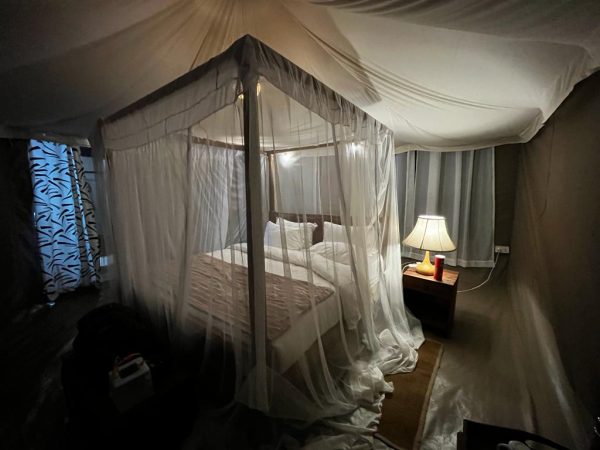
A giraffe greets us in the morning with a stroll through our tent camp.
We find zebras using a large boulder to scratch parasites off their belly.
We watch an elephant family stroll peacefully past our safari vehicles.
We spot (no pun intended, ok pun intended) two leopards high up in a tree – on a nearby branch, their morning kill.
Seeing the leopard completes our quest to see the Big 5!
We see birds of every size, shape, and color of the rainbow. Small sunbirds and large raptors.
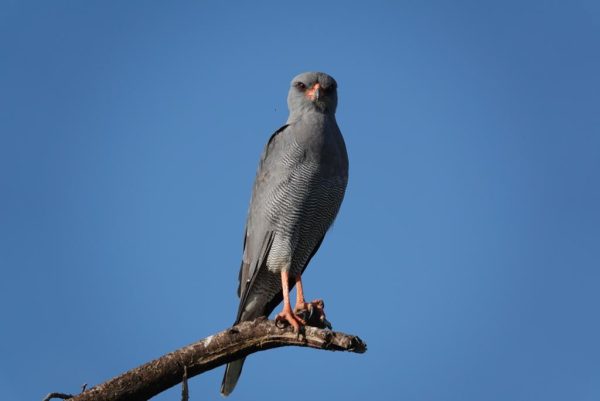

The Serengeti is home to the Great Migration. This is an endless circular cycle of millions wildebeests and zebras following the rains and food availability. It has no beginning and no end. We caught up to it on our way out. Wildebeests and zebras as far as the eye could see. Babies are born along the way and danger is all around.
Life is not easy on the Serengeti. Every living thing is hungry for its next meal. Many animals have those that stand guard, keeping a watchful eye for eagles, hawks, hyenas, leopards, cheetahs, and lions.
As we bid goodbye to the Serengeti we come upon a tree with seven lions draped among the branches. Can you find them all?
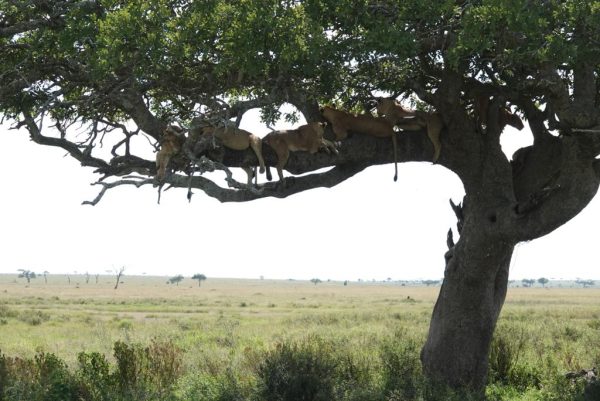
Sunset on the Serengeti. Serenity.
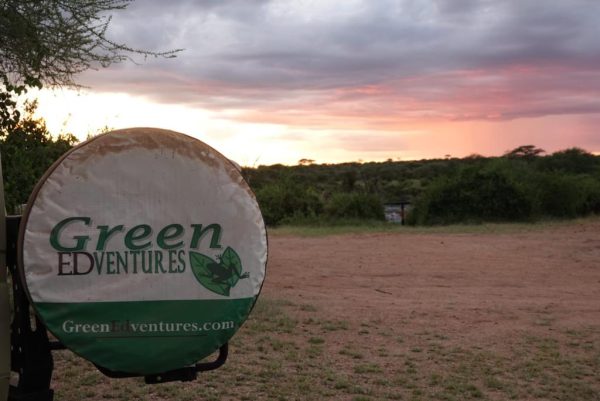
• Day 7 •
Serengeti species list
We spend three days and three nights on the Serengeti. It doesn’t take long for everyone to sharpen their ‘game eye’ and spot something new. Sometimes we need our binoculars. Sometimes, a lion is lying on the shoulder of the road just outside the door of our safari vehicle.
Did you know that a hippopotamus has whiskers??!!
If you like wild animals, this trip is for you!
If you like birds of every shape and size, this trip is for you!
If you like wide open spaces and skylines that never end, this trip is for you!
Join our Facebook Interest Group to be the first to know when registration is open for our 2024 trip!
Below is just a partial species list. LOL!!
Helmeted Guinea fowl, White headed Buffalo weaver, Warthog, Grey heron, Silver backed jackal, Kori bustard, Greater wildebeest, Lichstein’s Hartebeest, Red headed agame lizard, Ostrich, Zebra, Village Weaver, Tawny Eagle, Blue capped Cordon-Blue, Arrow marked babbler, Coqui Frankulin, Common eland, Speckled pigeon, Common rock kestrel, African fish eagle, Red billed ox pecker, Yellow billed ox pecker, Pied Kingfisher, Arrowmat warbler, d’Anarud’s Barbet, Red cheeked cordon blue, Leopard, Black crake, Black headed heron, White browed cuckoo bird, Water thicknee, Rock Hyrax, Eastern chanting goshawk, Jackel, Hornbill, Lizard buzzard, Square tailed drongo, Giraffe, Cape Buffalo, Steel blue whyda, Sun Grouse, Bare faced Go away bird, Purple Grenadier, Dwarf Mongoose, Hildabrant Starling, Von Der Decken’s hornbill, Ruppell’s long tailed starling, Topi, Grey headed heron, Egyptian goose, Blacksmith plover, Hippopotamus, African Hoopoe, Nile Crocodiles, Northern white crowned shrike, Vervet Monkey, lilac breasted roller, Ringed necked dove, Hartebeest, Secretary bird, Lesser striped swallow, Northern white Crowned shrike, Elephant, Pygmy falcon, White headed Buffalo weaver, Fisher’s lovebirds, Ostrich, Rufus tailed weaver, Kori bustard, Tse tse fly, Cheetah,reedbuck,Read headed agama lizard,Olive baboon, Two banded plover,Two banded courser,Pin tailed whydah Red necked spur fowl, Ruppell’s Griffon Vulture,Variable sunbird,Augar Buzzard,Common Stonechat,Widow bird (long tail!),Bishop bird,Hildibrant’s Starling,Banded mongoose,Agama lizard,Giraffe, Grant gazelle,Thompson Gazelle,Zebra,Pale Chanting Goshawk,Wildebeest,Laughing dove,Weaver,Superb mongoose,White backed vulture,Lappet face vulture,Tawny Eagle,Crowned Plover,Blacksmith Plover,Lions,Water thick-knee bird,Masked weaver,Jackal,Black bellied bustard, Hyenas, Maribou Stork, Dik dik, Impala
• Day 8 •
Part 1: Cultural Day
Today we met with the people of the Hadzabe (African bushmen) tribe. The Hadzabe people are nomadic and live in the hills of the Lake Eyasi area. The tribe we visited has 20 members.
They do not keep track of their age. Their philosophy is simply- you are born, you live, you die.
They speak with a fascinating click language. One of their leaders attempted to teach us a few words. It’s very difficult. The click sound is made at the same time as the spoken word. I’ve been unable to replicate it!
Birds are hunted with a blunt piece of corncob attached to the end of the arrow. They have a wide variety of arrow tips to choose from, depending on the size of the animal being hunted. Larger animals (antelope, etc) are hunted with a poison tip arrow. They create the poison from the desert rose plant.
They live completely off the land. The men hunt in the morning and at night. They took us on a hunt, scrambling through the brush and up and down small ditches.
We pass a large baobab tree with wooden sticks inserted to create a makeshift ladder. They know a nest filled with honey is at the top. At times, they’ll also climb trees to gather bird eggs.
They know the branches of the Salvadora persica tree can be used as toothbrushes and which trees can be scored to reach a milky sap that can be used as a lotion for skin or soap to wash yourself.
Their hunts today were successful, claiming two birds and a small dik-dik. The older tribesmen brought back two antelope. We’ve seen the circle of life play out on the Serengeti and now it’s right in front of us. This tribe needs to hunt in order to survive.
The tribesmen whistle while hunting to communicate with each other and to ensure no one is in the line of a flying arrow.
When the hunt is done they teach us all how to use a bow and arrow, aiming at a chunk of wood a ways away.
Next, we joined them in dance! The universal language. They are a very happy people!
Their priorities each day are family, food, and shelter. It’s clear – We have more in common with them than differences.
Part 2: Cultural Day
Datoga tribes
We met with two different clans of the Datoga tribes — the pastoral (farmers) and the metalworkers/blacksmiths.
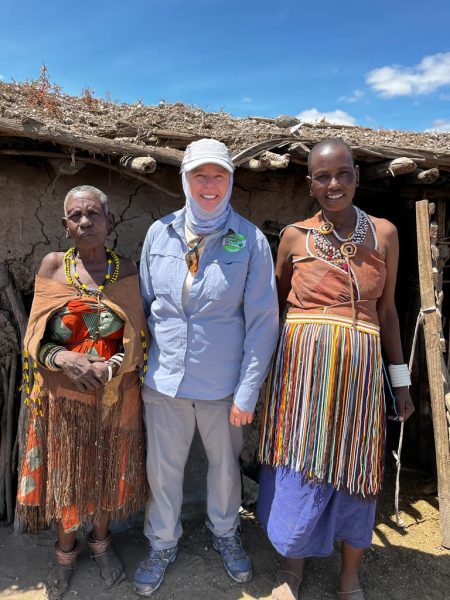
The pastoral chief is 95 years old and currently has 9 wives. When we asked him (through our interpreter) about the number of children he has, he answered “I don’t know. Ask the women.” They state the number as 100.
He is considered a wealthy man by his large herd of cows and his large family. He is widely known for his wisdom and kindness. The women invited us to help milk the cows. They use hollowed out gourds to collect the milk.
The women dress in beautiful cowhide dresses that are decorated with elaborate beadwork.
The color blends in with the soil color of the area. Their homes are made of mud and cow dung.
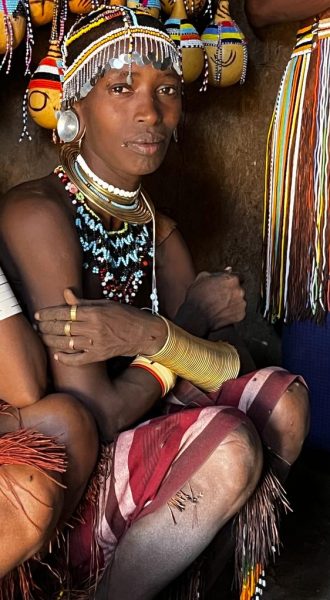
They invited us inside, showed us how to grind corn and gave us a chance to give it a go!! It’s hard work!
They, too, are a happy people that love to sing and dance. We had the opportunity to purchase their beadwork.
Part 3: Cultural day
Datoga tribe: Blacksmiths
The blacksmith clan recycle scrap metal found in nearby villages. They collect old locks, scrap piping, nails, aluminum. They melt it down using a hand bellows made from cowhide to create a hot fire. The molten metal is poured into a mold, cooled down in a pan of water, then pounded into bracelets, arrowheads, tools, etc.
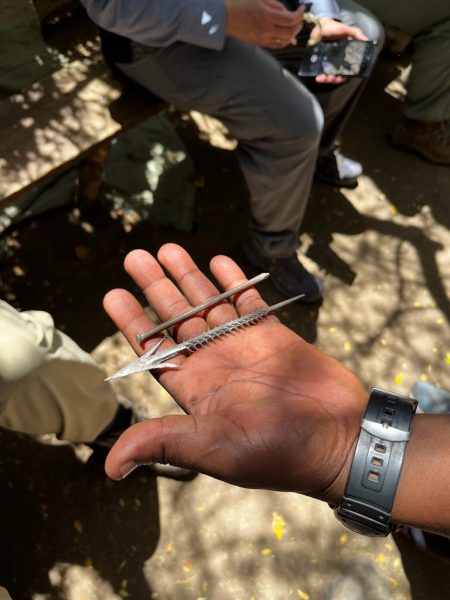
We watched as a single large nail was pounded and cut into a very large barbed arrowhead. They trade these arrowheads with the Hadzabe tribe in return for honey.
They, too, have a selection of goods for sale.
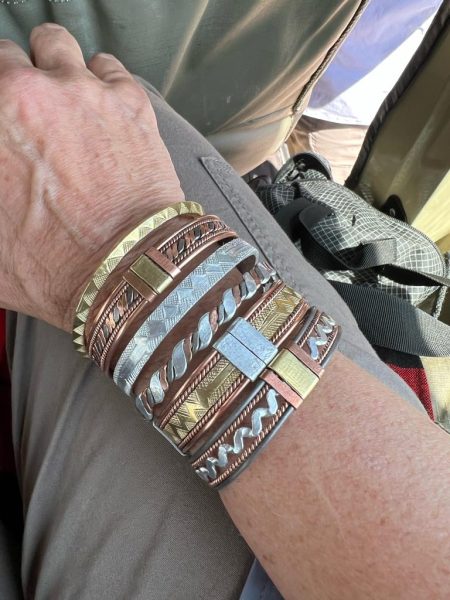
One of the women in this tribe has become my friend. Her name is Marekwa. We greet each other with a big hug.
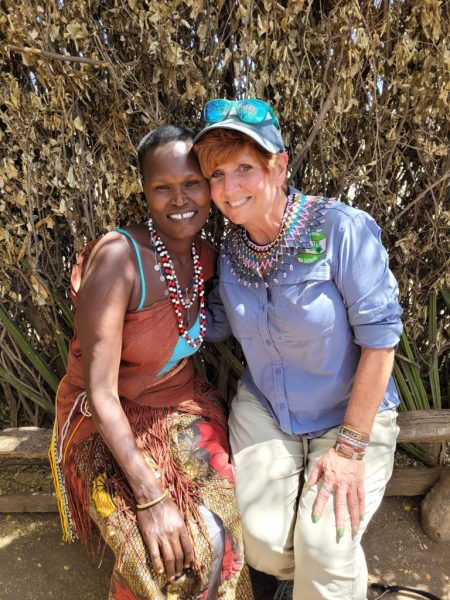
We don’t know each other’s languages but we are friends from the heart. I’m surprised to learn she is a grandma, she looks so very young. She proudly leads me inside her hut to see the new grandbaby. I wish her well until we meet again.
One could look around these villages and think, ‘They have nothing.’ Or, one could see they have the three essentials- family, food, shelter – and think, perhaps they have everything. And perhaps – they have more to teach us than we could ever teach them.
Back at our lodge for the evening we gather around the pool for a sunset happy hour. Unbeknownst to us, our guides have gone back to the Datoga pastoralist village, picked up the women and brought them back for more singing and dancing.
A truly perfect ending to an extraordinary enriching day on our Tanzania Women’s Adventure Safari Best of Northern Circuit!
• Day 9 •
Tarangire National Park
Our last game drive before we head home!
Tarangire National Park is a Tanzania’s 6th largest park and home to more elephants per square kilometer than any other park.
We saw Impala, waterbuck, warthogs, fish eagle, Marshall eagle, and much more!
A large flock of quelea birds kept us entertained with their flying in tight large groups, bobbing and weaving over the tall grass.
A large herd of Cape buffalo were just as curious to watch us as us them.
A number of elephant families were walking through the grasslands on their way to water. The babies are hilarious as they try to get their trunks under control.
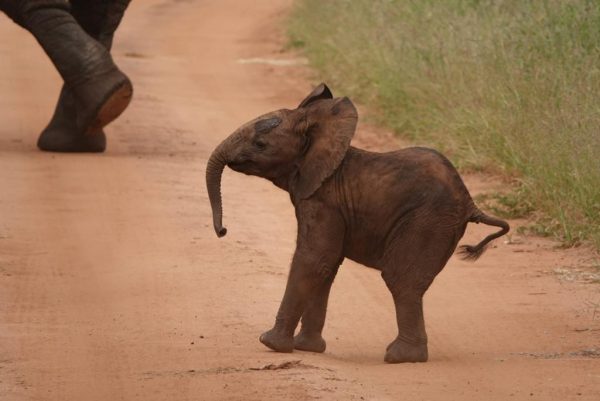
The day in the park ended with sighting a pride of nine lions. Some posed on a termite mound while others relaxed in the shade of a tree. Soon, they all moved in unison to the opposite side of the road and settled under a large bush.
Back at our beautiful tent lodge we enjoyed the pool at sunset. Our night was ended with a presentation by our guides and shared reflection on our week in Tanzania.
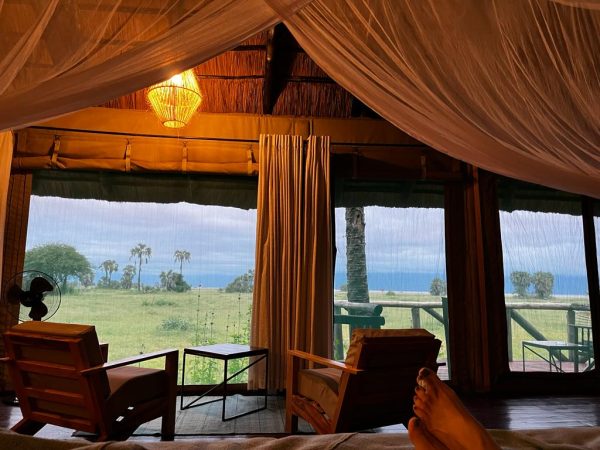
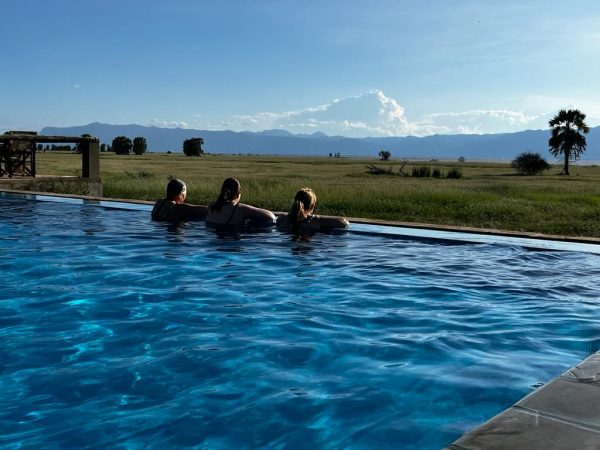
Tanzania! You have stolen our hearts!
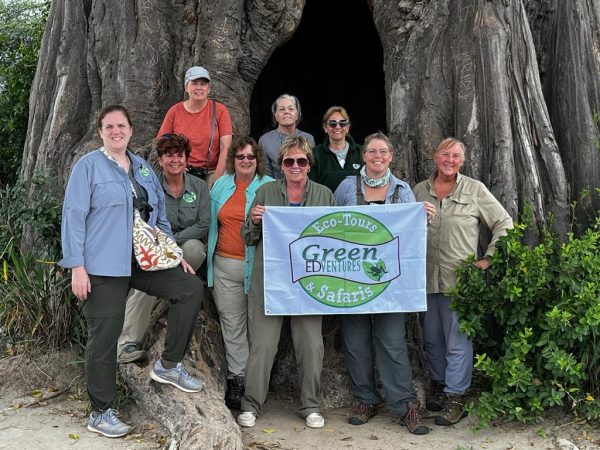
If Tanzania is a trip you dream of, please join our Facebook Interest Group, and receive updates and information on dates for next year.
Click here for details and trip highlights for our Tanzania Women’s Adventure Safari Best of Northern Circuit.

